The year 1918 was a momentous one, bringing an end to the First World War. Some of the pennies minted that year have become highly valuable. But which ones stand out – and what makes them so special?
That’s exactly what we’re about to uncover. We’ll examine the value of 1918 pennies, the key factors that influence their worth, and explore their history and design along the way.
Curious to find out how much your 1918 penny could be worth? Let’s dive in!
1918 Penny Value Chart
| Mint Mark | XF45 | MS60 | MS65 | MS67 |
|---|---|---|---|---|
| 1918 (P) No Mint Mark | Brown: $8 | Brown: $32 Red & Brown: $35 Red: $50 | Brown: $260 Red & Brown: $325 Red: $550 | Red: $4,250 |
| 1918 D | Brown: $36 | Brown: $120 Red & Brown: $130 Red: $175 | Brown: $575 Red & Brown: $1,300 Red: $4,750 | Red: $100,000 |
| 1918 S | Brown: $32 | Brown: $110 Red & Brown: $130 Red: $225 | Brown: $725 Red & Brown: $1,500 Red: $9,000 | N/A |
This table provides a general idea of what these coins are worth based on their condition and color. Let’s take a closer look at what makes these pennies so valuable!
History of the 1918 Penny
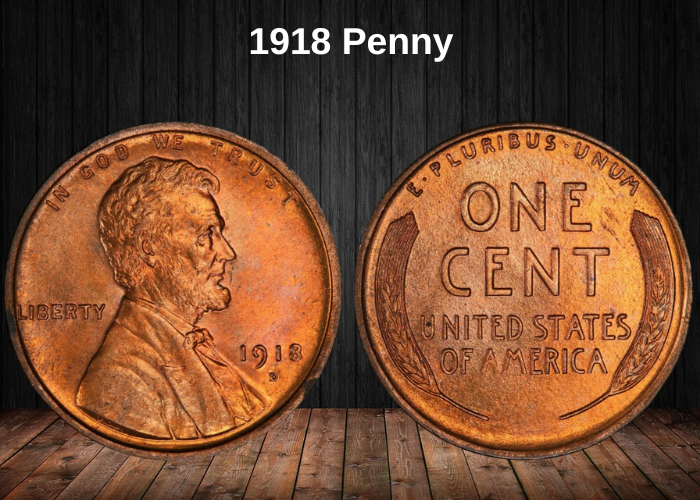
The penny minted in 1918 is part of the well-known Lincoln penny series, specifically the Lincoln Wheat penny. It gets its name from the portrait of President Abraham Lincoln on the front and the two wheat stalks featured on the reverse.
Lincoln’s image first appeared on U.S. pennies in 1909, introduced to commemorate the 100th anniversary of his birth. As preparations for the bicentennial took shape, public admiration for the former president grew even stronger.
Before Lincoln’s portrait was added, U.S. coins traditionally featured allegorical figures like Lady Liberty. However, increasing public demand led to a historic change—placing a real historical figure on American coinage for the first time.
While Lincoln pennies are still in circulation today, their reverse design has evolved over the years. The 1918 edition retained the original imagery introduced in 1909, featuring two ears of durum wheat.
Notably, early Lincoln pennies initially omitted the designer’s initials, Victor David Brenner, due to concerns that they were too conspicuous. However, the 1918 series marked their return, subtly placed on the obverse at the base of Lincoln’s shoulder.
Features of the 1918 Penny
The Obverse of the 1918 Penny

If you examine the obverse—or “heads” side—of the 1918 penny, you’ll notice a familiar face. The portrait of Abraham Lincoln, designed by artist Victor David Brenner, is still used on modern U.S. cents.
Brenner depicted Lincoln in profile, facing right. He explained that he imagined Lincoln as if he were reading to a child, capturing a warm and engaging expression.
Since Lincoln had passed away long before this design was created, it is believed that Brenner based his work on a photograph taken at Matthew Brady’s studio. However, it is unclear whether Brady himself or one of his assistants took the photo.
As was common practice among artists of the time, Brenner wanted to sign his work, but his initials became a point of controversy.
Originally, he placed them on the reverse of the penny, but critics argued they were too prominent and seemed like self-promotion. Due to time constraints, the U.S. Mint chose the simplest solution: removing the initials entirely. It wasn’t until 1918 that they were reinstated, this time discreetly on Lincoln’s shoulder.
The motto “IN GOD WE TRUST” is inscribed above Lincoln’s portrait, while the word “LIBERTY” appears to the left. The date is displayed to the right, slightly lower.
If the penny was minted in Denver or San Francisco, you’ll find a small “D” or “S” just below the date, indicating its place of origin.
The Reverse of the 1918 Penny

The simple design on the reverse of the 1918 penny was also created by Victor David Brenner. However, it wasn’t his first proposal. Initially, he suggested a tree branch, but Mint officials rejected it, noting that it closely resembled designs on contemporary French coins.
As a result, Brenner redesigned the reverse, ultimately choosing an image featuring two ears of durum wheat. These stylized wheat stalks curve along both sides of the coin, framing the central denomination.
The denomination dominates the reverse, written in large, bold font as “ONE CENT”.
Above it, the Latin motto “E PLURIBUS UNUM” follows the curvature of the upper coin edge. This phrase means “From the many, one”, symbolizing the formation of the United States from individual states.
Below the denomination, in smaller lettering, are the words “UNITED STATES OF AMERICA”.
Other Features of the 1918 Penny
The 1918 penny is composed of 95% copper, with the remainder being a mixture of tin and zinc. This composition classifies it as bronze. The coin has a diameter of 19 millimeters and a weight of 3.11 grams.
Due to its high copper content, the coin changes color over time as it is handled and exposed to air. Initially, it appears red, but it gradually dulls to brown as oxidation occurs.
The color of a Lincoln penny plays a crucial role in determining its value. Generally:
- A penny graded red is worth more than one graded red and brown.
- A red and brown penny is, in turn, more valuable than a brown one.
In many later mintages, only red pennies hold significant value beyond their face value. However, 1918 pennies remain collectible in all color grades.
To be classified as “red”, at least 95% of the coin’s surface must maintain this color. Coins classified as “brown” must have 95% brown coloration. If a coin exhibits a mixture of both, it is designated as “red and brown”.
1918 Penny Grading
| # | Grade |
|---|---|
| 1 | Basal State-1 |
| 2 | Fair |
| 3 | Very Fair |
| 4, 5, 6 | Good |
| 7, 8, 10 | Very Good |
| 12, 15 | Fine |
| 20, 30 | Very Fine |
| 40 | Extremely Fine |
| 50 | About Uncirculated |
| 60 | Mint State |
| 65 | Mint State |
| 70 | Mint State |
📌 Check our grading guides to determine your coin’s grade—it’s an essential step in accurately assessing its value!
1918 Penny Value Guides
1918 No Mint Mark Penny Value
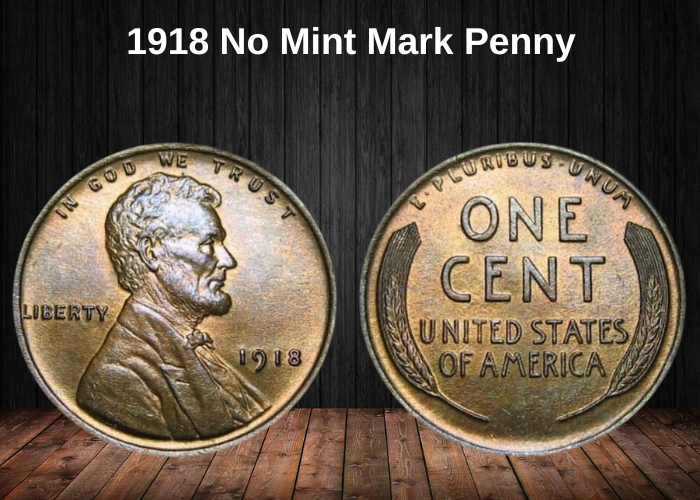
1918 pennies struck in Philadelphia tend to have a clearer strike than those from Denver or San Francisco. There were also far more of them – the Philadelphia Mint struck over 288 million pennies that year, more than twice the combined total of the other two facilities.
Both these factors mean that it’s generally easier to find 1918 Philadelphia pennies in good condition than those from Denver or San Francisco. And that in turn means that values are slightly lower at most grades for pennies without a mint mark.
Brown 1918 Philadelphia Penny Value
- XF45 (Extremely Fine Circulated Condition) → $8
- MS60 (Lowest Grade of Uncirculated Coin) → $32
- MS65 (Gem Condition) → $260
- MS66 (Finest Brown Certified by PCGS) → $325
Red-Brown 1918 Philadelphia Penny Value
- MS61 → $40
- MS65 (Gem Condition) → $325
- MS66 (Finest Certified by PCGS) → $375
Red 1918 Philadelphia Penny Value
- MS62 → $70
- MS64 → $200
- MS65 → $550
- MS66+ → $1,000+
- MS68 (Finest Certified by PCGS, Only Three Known) → $80,000
Red pennies, by definition, are usually available only in higher grades. Their value rises sharply at top-tier grades, making them some of the most valuable 1918 Lincoln cents in existence.
1918 D Penny Value
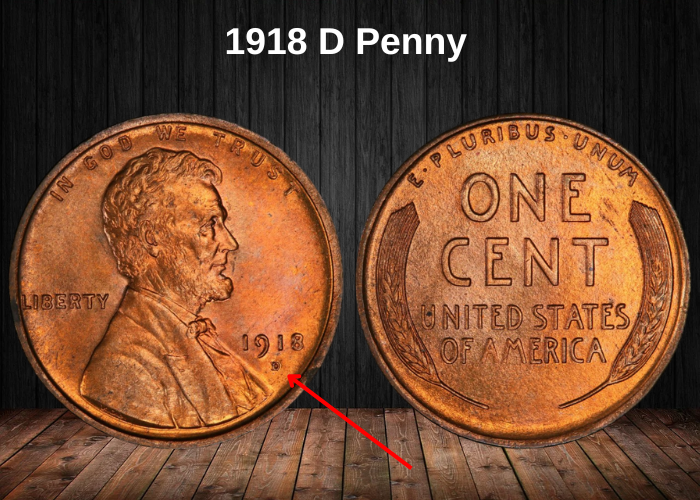
The Denver Mint facility struck just under 48 million pennies in 1918. Today, it’s estimated that 4.5 million brown coins survive, 950 red and brown, and just 800 red.
These survival estimates are reflected in values. Brown coins are available in circulated grades from 3 upwards, and are worth around $1 apiece. That value rises to around $24 at grade 35 and $36 for an extremely fine XF45.
In uncirculated condition, brown coins start at $120 at MS60, rising to $575 at MS65. For red and brown coins at the same grades, the values are $130 and $1,300. The finest red and brown examples are graded MS66 and valued at $5,750.
If you’re looking for a red 1918 Denver penny, the available grade range is from AU53 (“about uncirculated”) to MS67. Mint state examples start at $175. But if you want a coin graded MS66 or above, you’ll be looking at a five-figure price tag.
At MS66, a red 1918 Denver penny is valued at $23,500. If the condition is graded half a point higher, that value rises to $65,000. And the sole example certified at MS67 is worth a cool $100,000.
1918 S Penny Value
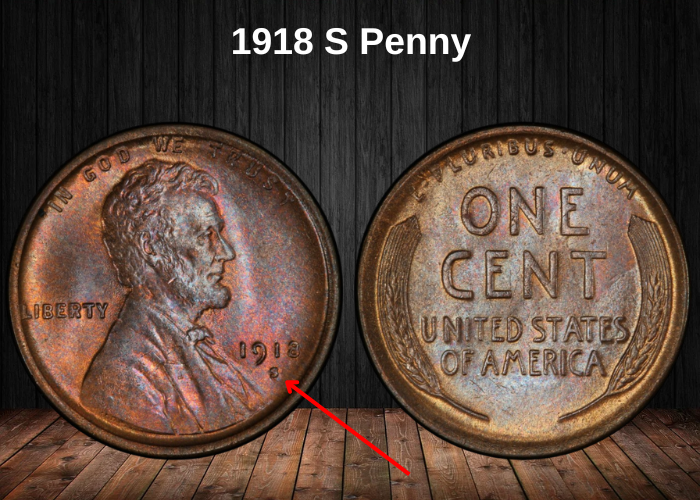
The San Francisco Mint facility contributed 34.7 million pennies to the 1918 total. And because the strikes tended to be weak, good quality examples with the “S” mint mark are highly collectible.
Brown coins in the lowest circulated grades are worth less than $5. There’s a slight premium for coins graded 1, which are worth around $5 each.
Values rise to $10 at VG15 (“very good”) and $18 at VF25 (“very fine”). Uncirculated brown pennies range from $110 at MS60, to $3,400 for the best-in-class MS66.
Red and brown coins can be yours from around $130 at MS60, to $5,250 at MS66. And red examples start at $225 for an MS60, although the PCGS has also graded a handful in circulated grades.
The finest known red 1918 San Francisco pennies are three coins graded MS65+ and worth $33,000 apiece. The relatively low grade neatly illustrates the striking problems encountered by the facility.
Rare 1918 Penny Errors List
1918 (P) Penny, Struck Nine Times
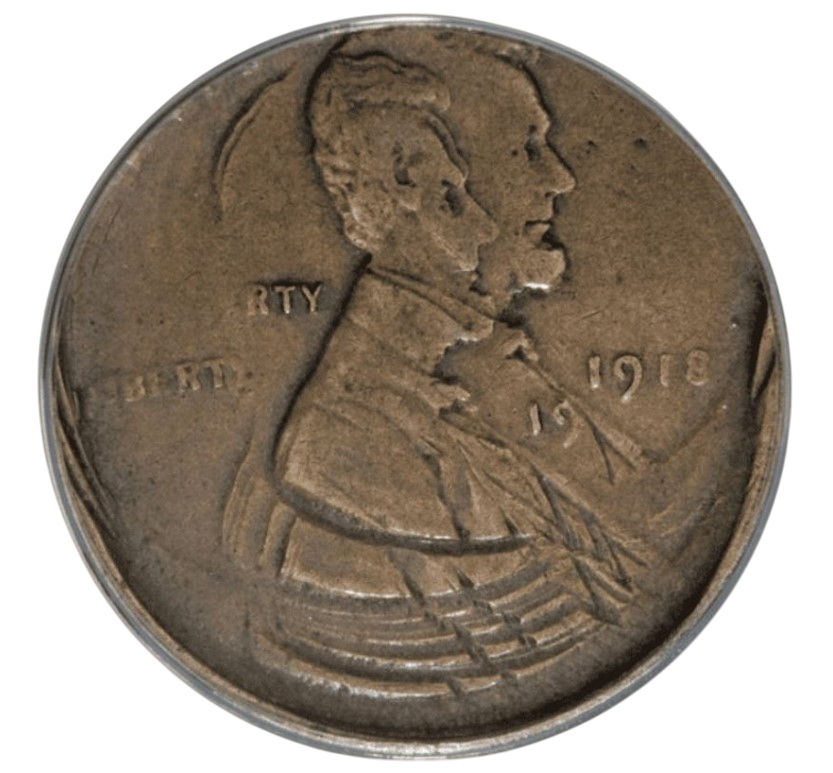
Very occasionally, a coin isn’t ejected from the coin press after striking. It’s then struck a second, or even a third time. But one penny minted at the Philadelphia facility in 1918 was struck no fewer than NINE times.
The brown coin had been circulated and showed plenty of signs of wear. The independent coin graders ANACS certified it as F15 (“fine”). But the rarity of the error meant that, when it was presented at auction, it sold for $2,000.
1918 (P) Penny, Struck Off-Center and Lamination Error
Sometimes, coins combine more than one kind of error. That was the case for one 1918 Philadelphia penny which was both struck off-center and had a lamination error.
The strike was around 25 percent away from where it should have been, moved towards the 1 o’clock position. A shallow lamination error on the upper left of the reverse didn’t interfere with the design. The coin also had some attractive toning.
It was graded MS64 red and brown by the coin grading agency ANACS. And it sold at auction in 2019 for $500.
This YouTube video from Couch Collectibles looks at both errors and high-grade 1918 pennies, along with other examples of error coins amongst Lincoln cents.
Where to sell your penny?
Now that you know the value of your penny, you might be wondering where to sell it. Don’t worry: here’s a guide to some of the best online platforms where you can easily sell your coins, along with their advantages and disadvantages.
Discover the best platforms for selling coins online (pros and cons).
FAQs
How much is a penny from 1918 worth today?
Almost any penny from 1918 will be worth more than its face value, but its value depends on several factors, including its condition, color, and mint mark.
- Brown 1918 pennies in lower grades are worth around $1.
- The very finest red pennies can be worth tens of thousands of dollars.
- If your coin has a mint error, it can add a significant premium to its value.
How rare is a penny from 1918?
- Philadelphia pennies are the most common from the 1918 mintage. If there’s no mint mark beneath the date, it’s from Philadelphia.
- It’s estimated that about 28 million brown 1918 Philadelphia pennies survive in all grades, so they aren’t considered rare. However, in uncirculated condition, that number drops to around 2,750, with just about 1,200 gem-quality examples.
- Red and red-brown pennies are rarer, with around 2,750 survivors in each color at all grades.
- Denver mint-marked pennies are more difficult to find:
- About 4.5 million brown Denver pennies survive, but only 950 red and brown and 800 red pennies exist. Gem-quality examples of each color number fewer than 200.
- San Francisco mint-marked pennies are very rare in good condition:
- Around 3.5 million brown 1918 San Francisco pennies survive, but only 1,300 of them are in mint state. There are about 1,300 red and brown survivors, and only 500 red ones, with just 90 of those in gem grades.



















































